With the pink flamingos on in bewilderment a wind surfer skims over the surface of the water in a flash of colour that stands out in vivid contrast against the blue of the sea and the sky. Children play happily, building castles in the sand. Holidaymakers lie contentedly in the sun, putting the finishing touches to their tan while others stroll along the shore. A game of volleyball gets under way...
To the gentle lapping rhythm of the waves, your skin deliciously caressed by a warming sun, your relax on a chaise longue with your hands buried in the warm sand, idly watching everything happening on the beach and reflect with a smile, "How delightful it is to do nothing in the middle of all this activity."
In 1505 the tiny village of Agadir made its first mark on history. The Portuguese set up a trading post there, defended by the Santa Cruz fortress on Cap de Gué. A profitable, but brief stay. In 1541 they were ejected by the founder of the Saadian dynasty, Mohamed Echeikh el Mehdi. The Golden Age of Agadir then followed, with ships arriving every day to take on cargoes of sugar cane, dates, wax, oils, spices and gold.
But over the years Agadir went into decline until, in 1960, it was destroyed by an earthquake. "If it was Agadir's destiny to be destroyed, its reconstruction will depend on our faith and our determination", declared the late Mohamed V, King of Morocco.
So here is the new Agadir, the holiday capital!
Constructed away from the areas at risk, using anti-seismic techniques, Agadir is an engaging town, the dominant white of its sculptural buildings contrasted with the multi-coloured flowers that adorn its tranquil gardens.
There is an ultra-modern airport, an imposing central post office and primary school and the monumental courthouse. Near the mosque, the holidaymakers drink in the sea air, sitting at tables on the cafés terraces or strolling around the bazaars. While a little further away there is all the bustling activity surrounding the most important fishing port in Morocco, with its fleet of spruce trawlers bobbing up and down on the Atlantic swell.
Take a deep breath, fill your lungs with the pure, salty air, let the energy flow through you and... go for it!
Head out towards the horizon under full sail, leap onto a thoroughbred and gallop across the beach at full speed, ride the breakers on a surf board, climb into the sky with a parachute over the water or drive beneath it to admire the richly varied submarine life and finish in style on one of the most beautiful golf courses in Morocco, with a birdie at the 18th hole. Or you might prefer to go deep sea fishing off Cap Ghir and catch a tunafish, or win a set on one of the 150 tennis courts before taking a dive into one of the towns' many swimming pools...
In Agadir, sportsmen (and women) feel they are in heaven.
An invitation to discovery:
A succession of breathtaking landscapes. Awesome waterfalls, the mauve sky at sunset, unspoiled beaches stretching as far as the eye can see...
Towns with a magic that seems to belong to another age. Strangely different peoples, tribes with traditions rooted in history...
From the High Atlas to the plain of Souss and the Anti-Atlas, and all along the Atlantic coast: the roads from Agadir will take you towards fascinating, exciting experiences - and a welcome that will be quite unforgettable.
The adventure begins 12 km North East of Agadir, on the Imouzzer road in the country of the Ida Ou Tanane Berber tribes. Suddenly, with a view over an incredibly beautiful palm grove you come upon a bare landscape, bearing the scars of mighty geological upheaval. And there stands Imouzzer, the town of white houses.
Gateway to the Deep South
The
shady
path
winds
its
way
towards
a
series
of
impressive
waterfalls
that
surge
from
the
rock
at
different
levels.
You
pass
by
fields
of
barley,
olive
groves
and
almond
trees
that
are
a
have
for
flocks
of
white
doves
and
-
found
only
in
Morocco
-
the
argan
trees
which
goats
climb
so
energetically
in
search
of
their
leaves
and
fruit.
In
the
fertile
plain
of
Souss
stand
line
after
line
of
orange,
banana
and
olive
plantations.
Then,
11
km
from
Agadir,
you
come
to
Inezgane
where
a
souk
is
held
every
Tuesday
that
attracts
large
numbers
of
people
from
its
large
neighbour
on
the
coast.
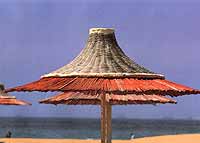
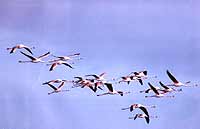
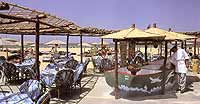
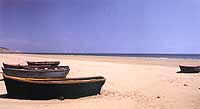
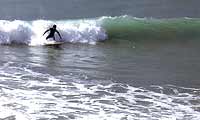
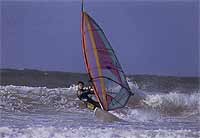
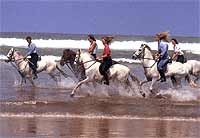
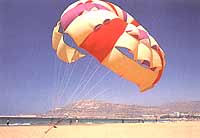
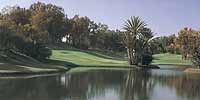
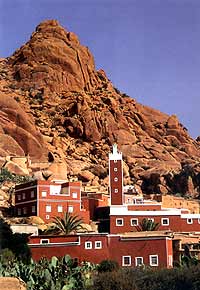
This is a totally different world. In Tiznit, the local people still wear traditional costume. Protected by its pink-coloured walls and battlements, the town has retained much of its atmosphere as an oasis. But the heart of Tiznit is its souks of jewellers, where master craftsmen create magnificent necklaces, bracelets, head dresses, belts, buckles, rings and brooches... all with the purity of line that is so characteristic of Berber jewellery.
In the Ammeln region, Tarfraoute is hidden away at the heart of the pink granite mountains that form a natural circus around it. It is a unique spot, strange and grandiose at sunset - when the sky catches fire and goes on glowing red before slowly turning mauve, when the rocks flare up and the pale, ochre-coloured houses melt away into the green of the almond and fig trees.
Taroudannt is nicknamed "the little Marrakesh." With justification. For everything is a reminder of the great queen of the south. Its earthen ramparts, its fragrant gardens which take up more room than the houses, its colourful souks, protected by the shade of wattle screens, its narrow streets that wind in all directions filled with ceaseless agitation which is at its most intense beneath the arcades of the Place Assarag and in its tiny cafés, the favourite meeting place of the Roudanis, inhabitants of Taroudannt.
EGYPT - LEBANON - SYRIA